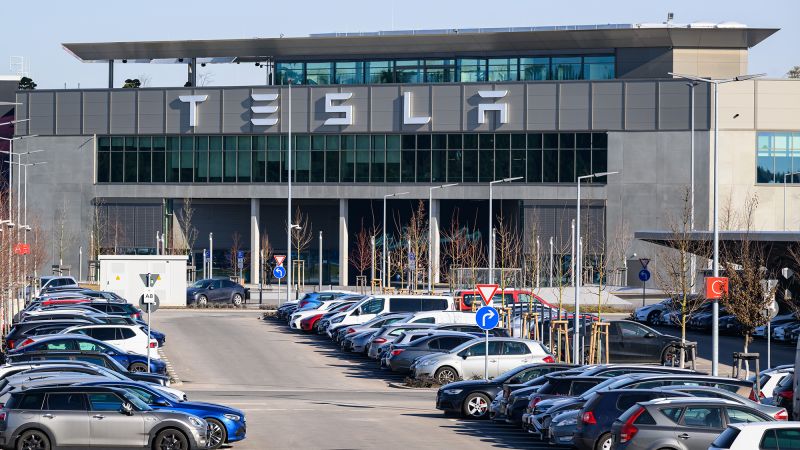Tesla, the electric vehicle (EV) powerhouse founded by visionary entrepreneur Elon Musk, finds itself amid a turbulent sea, grappling with declining sales, dwindling profits, and a vulnerable stock price. The company faces unprecedented challenges, highlighted by the somber reality that its once-booming trajectory has hit a snag, leading to protests outside its showrooms and criticism of its recent product launches, including the Cybertruck, which many regard as underwhelming.
The latest financial reports reveal a staggering 71% reduction in net income, overshadowed by Musk’s announcement regarding his stepping back from his controversial roles, including his leadership at the Department of Government Efficiency (DOGE). Such figures point to a profound financial malaise, evidenced by a historic drop in sales. In fact, for the first time in Tesla’s history, sales have encountered a decline, supported further by lowering prices across the EV market. This troubling trend signifies a deteriorating bottom line for a company whose primary mission hinges on selling vehicles.
A closer examination of Tesla’s first-quarter earnings uncovers a bizarre reality: the automaker recorded a mere $409 million profit, predominantly buoyed by the sale of $595 million worth of regulatory credits to rival automakers. This revelation raises a red flag, particularly with potential changes on the political horizon that could eliminate such sources of income. If the Trump administration proceeds with its intentions to abolish the protective measures favoring manufacturers of EVs, these regulatory credits, which have historically provided a financial cushion, may soon vanish.
Additionally, potential tariffs under consideration by the Trump administration for imported auto parts threaten to increase production costs. Musk has acknowledged that these tariffs could significantly impact the company’s operations, albeit he reassured stakeholders that the effects may not be as dire as for competitors. Nevertheless, the ongoing competition in the EV market, especially against prominent automakers in China, compounds Tesla’s woes. As competitors ramp up their production, Tesla’s market share is at stake, as evidenced by the imminent challenge from BYD, a Chinese brand poised to eclipse Tesla as the top EV seller globally.
Musk’s controversial political engagements have further complicated the company’s image, causing concern among even the most ardent investors. Many believe that the political affiliations and activities associated with Musk, particularly his support for far-right parties, have inflicted lasting harm on the Tesla brand. Musk, however, remains optimistic, downplaying fears of financial distress. In recent investor calls, he claimed that the company had navigated through numerous crises in the past and reiterated confidence in Tesla’s future despite acknowledgment of challenges ahead.
Yet, absent from Musk’s optimistic commentary was a discussion on the imminent risk posed by the possibility of revising federal emission standards. If the new administration eliminates regulations supporting EV sales, the subsequent drop in demand for regulatory credits could force Tesla to reassess its financial strategy. Regulatory credit sales have proven immensely profitable for Tesla, accounting for $8.4 billion in revenue since the onset of 2021. This income stream has previously been pivotal for maintaining profitability, particularly during periods when car sales did not meet expectations. Up until the current quarter, Tesla had enjoyed a consistent profit margin before becoming ensnared once more in red ink.
As financial performance deteriorates, gross automotive profit margins have also sharply fallen from a high of 30% in early 2022 to just 12.5%. Analysts indicate that such margins haven’t been witnessed since 2012, a time when Tesla was just emerging with a small production volume compared to its current output. This erosion in profitability has sparked debates on whether Tesla can sustain its market-leading position in an increasingly competitive landscape.
Despite numerous challenges, some analysts and investors remain hopeful about Tesla’s long-term prospects, particularly with the anticipated development of “robotaxis” intended to generate a new revenue stream from ride-hailing services. Musk’s vision balances optimism with caution, as the recent announcement by the Department of Transportation to lessen regulatory barriers appears to favor Tesla’s automated vehicle program. Nevertheless, historical failures in meeting ambitious timelines call for a tempered perspective on the timeline for these futuristic services.
Gene Munster from Deepwater Asset Management attributes current challenges to both sales drops and increased research and development expenditures. While he acknowledges the grim realities of this fiscal year, he contends that the groundwork being laid now prepares for future improvements. However, skepticism remains prevalent in the industry, as established competitors like GM and Ford reevaluate their autonomous vehicle initiatives, suggesting that the road to profitable autonomy is fraught with obstacles.
Therefore, as Tesla ventures into uncertain waters, navigating dwindling profits, volatile regulatory environments, and the specter of intensified competition, both investors and observers shall wait with bated breath to see if the company can adapt and sustain its leadership in the electrifying automobile market. The future remains unclear, with both risks and potential breakthroughs on the horizon, as Musk’s ambitions continue to shape the narrative of electric mobility.



